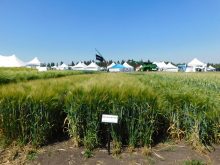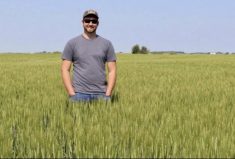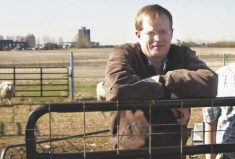To many agricultural producers, winter wheat is an unknown and untried commodity. But a new project by Ducks Unlimited Canada (DUC) is intended to show winter wheat can add to a producer’s pocketbook, the land’s productivity, and nature’s ecological balance.
This fall, DUC conservation specialist Bryon Wolters invited Lakeland’s crop technology students to take part in a land reclamation project to supplement their Student Managed Farm experience. The project, located southwest of Vermilion, is on a piece of DUC land that presented some particular challenges for the previous owner.
“The land — known as the Driver project — has 38 bodies of water, rolling hills, and some equipment access issues,” said Wolters. “This made it difficult for the previous owner to do much with it. Previous attempts to turn the land into grass did not go well, so when DUC took it over, we decided to reclaim it, and as part of the process, introduce a crop of winter wheat.”

Wolters called Josie Van Lent, dean of Lakeland ag school, to see if the project would be of interest to her and her students. She jumped at the chance.
“The timing of Bryon’s call was perfect,” says Van Lent. “For a while, we have wanted to do something with winter wheat on the Student Managed Farm.”
Lakeland’s students and DUC seeded 135 acres in mid-September, and the crop was off to a good start as of mid-November. The students also met at the site with Janine Paly, DUC’s winter wheat agrologist in Alberta, to discuss the crop.
“Winter wheat is an attractive crop for a producer to have in their crop rotation — it has the potential to be high yielding and very profitable,” said Paly. “It is, however, an underutilized and underappreciated crop on the Canadian Prairies.”
Read Also

Mid-June rain a ‘godsend’ but forage growers manage expectations
Although chunks of Alberta got some major rainfall the weekend of July 21-22, the jury’s still out on whether it will make a difference to what has so far been a mediocre year for hay.
Seeding the crop is challenging because of the short growing season, but worth the effort, said Paly.
“Producers who grow winter wheat are seeing multiple benefits which include added protection from soil erosion, and restored nutrient levels in the soil. The results so far on this site also indicate that winter wheat is well suited to this climate and geography.”
The students will learn more about weed management practices as well as marketing opportunities for winter wheat, said Lakeland crop technology instructor Peter Walsh.
“The milling industry especially likes winter wheat for its reduced protein and gluten levels,” said Walsh. “It has characteristics that are very desirable for baking flours.”
Winter wheat provides good nesting habitat for waterfowl, particularly northern pintail, whose numbers have been declining since the 1970s. The northern pintail is Alberta’s signature species, said Wolters.
DUC is partnering with Bayer Crop Science and Richardson International in the Western Winter Wheat Initiative. This initiative includes work being done with winter wheat on six “super sites” within Alberta. For more information, visit growwinterwheat.ca.















